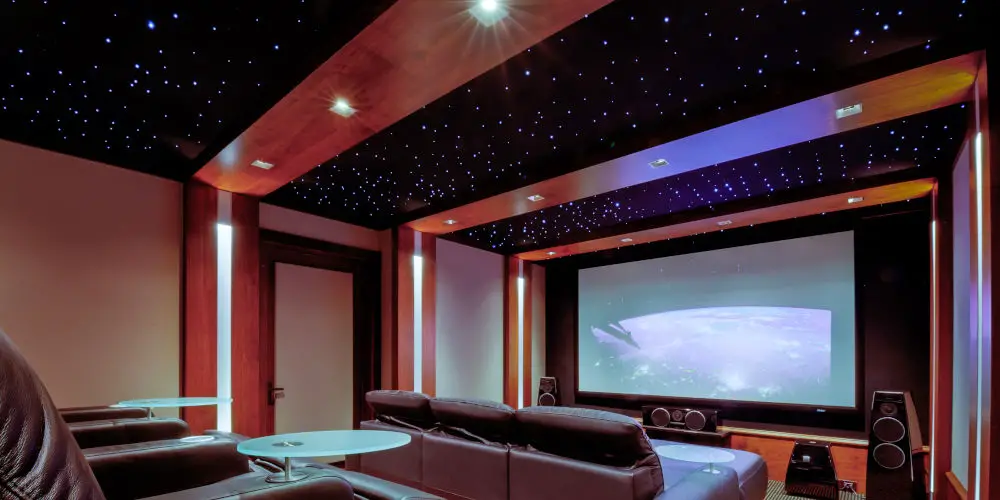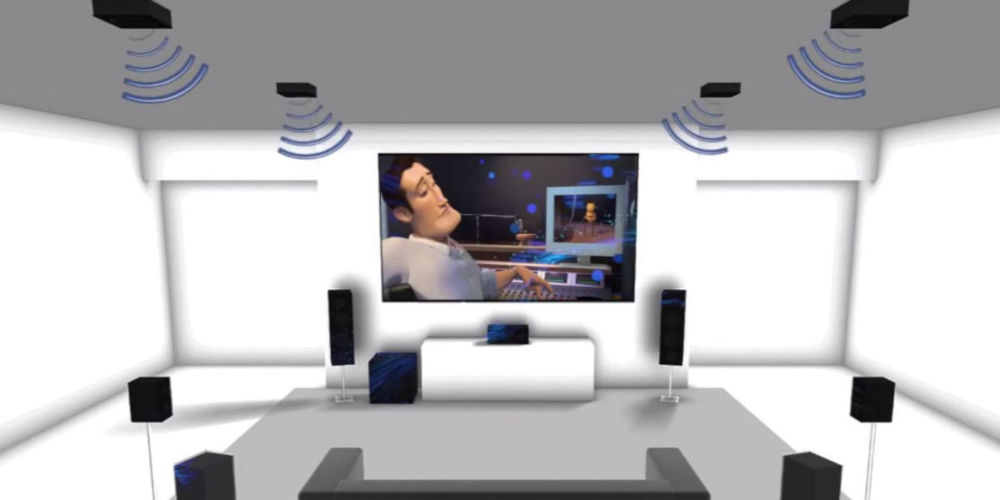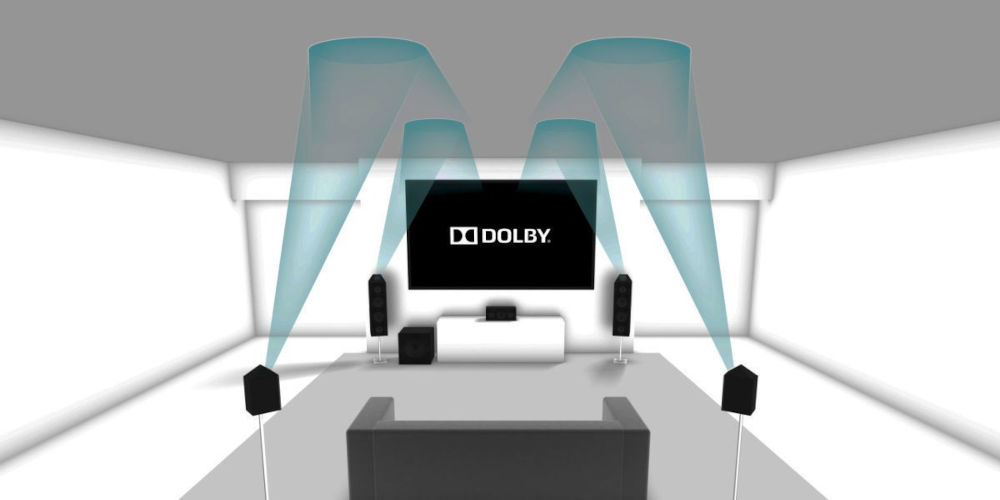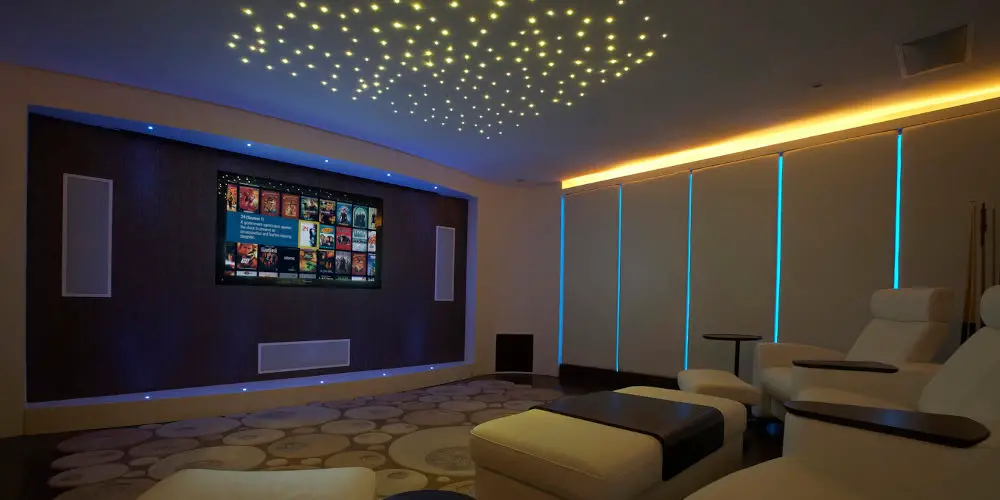What is Dolby Atmos and will it enhance movie nights?

A lot of home cinema enthusiasts settle for 5.1 or 71. surround sound, which while super isn’t a match for the depth and clarity of Dolby Atmos. Why invest thousands in the latest 4k projector and not consider if the audio experience matches the picture quality?
Thankfully, using Atmos, you can recreate a cinema-like experience at home, allowing you to enjoy the ultimate picture and audio. It’s akin to upgrading from Blu-rays to 4K Ultra HD media, the change in quality is instantly apparent.
Before you dismiss Dolby Atmos as a niche topic, most of the latest movie releases and some older titles, many sports broadcasts, and even games are available using the technology.
We’ll cover what is Dolby Atmos? Do you need it for your home cinema? And how to get the best from the system.
What is Dolby Atmos?
If you’re familiar with surround sound then Dolby Atmos is the next step up. It takes the basic surround sound and adds extra height channels, which create a more immersive audio experience. Rather than merely hearing the action, you begin to feel it.
These additional channels elevate certain sounds, placing them at the top of the audio field, rather than projecting them directly at your ears. Imagine listening to rain, for example. Using a 5.1 or 7.1 surround sound set-up, the droplets feel like they are horizontally hitting your ears.
Using Atmos, the overhead speakers move the sound of raindrops falling to above your head, making it sound and feel like you’re stood outside in a rain shower, albeit without the water or cold!
Another way to demonstrate how powerful Atmos is, consider a helicopter. It sounds weird if it’s flying across the top of the screen yet the sound is at ear level. Now imagine, the helicopter sound moves over your head as it departs from the scene. Far more realistic.
How do we denote these additional speakers?
Let’s start with a 5.1 speaker configuration. In this set-up, we have 5 normal room speakers and a subwoofer. Pretty standard stuff. With a basic Atmos set-up, we have two height channel speakers, which translates into a 5.1.2 speaker configuration.
It’s also possible to use a 5.1.4 configuration with 4 height channel speakers. If you’re using a 7.1 speaker set-up, then you can use either 7.1.2 or 7.1.4 configurations. And if you want more low-end power, you could add another subwoofer, giving you a 7.2.4 speaker configuration.

photo by ONKYO
So, is Atmos defined by the number of channels?
Not exactly, Dolby Atmos is defined by its enhanced ability to deliver a more immersive audio experience. Well, that’s how Dolby describes it.
In lame-man’s terms, yes as these extra channels that reproduce specific sounds in certain locations make up the Atmos system.
How can I easily add Dolby Atmos to my home cinema?
For the best possible Atmos experience, you’d install in-ceiling speakers. However, this isn’t always possible. One solution is to use upward-firing Atmos speakers. These devices fire the sound up toward the ceiling, sound waves then bounce off the ceiling reaching the listener.
Many manufacturers have adopted this methodology. It’s now common in a range of speakers, AV receiver and soundbars.
If you already have a 5.1 or 7.1 speaker set-up in your home cinema, then consider adding upfiring modules such as the Eltax Monitor ATM that can sit on top of your existing front left and right speakers, should they be on floor stands.
If not, you could use shelves or freestanding stands to support these additional speakers. These dedicated Dolby Atmos speakers are angled slightly to allow sound waves to bounce off the ceiling and back down to your sitting position.
If you’re considering upgrading your speaker configuration and want to use Atmos, then look for a speaker set that offers upfiring units as part of the front left and right speakers, such as the Focal Sib Evo Dolby Atmos 5.1.2 Home Cinema System. These project sound towards you and also upwards yet look like standard speakers.
In terms of powering these dedicated Dolby Atmos speakers, you’ll need an AV receiver that offers Atmos capabilities. Thankfully, there is a range of AV unit across the price spectrum that support Dolby Atmos speakers. Even with a limited budget, you should be able to enjoy the experience.

photo by ONKYO
Is Dolby Atmos available in soundbars?
If you don’t quite have space for a full surround sound set-up or the budget, you might wonder if you can buy a soundbar with Dolby built-in. Thankfully, most popular electronics brands offer some form of Dolby Atmos soundbars.
These range from models with upfiring speakers built into the top of the body to units that offer a virtual Atmos effect, which create an immersive expensive without directly projecting sound upwards.
As more manufactures introduce Atmos enabled soundbars to the market, prices soften. Even in the last few years, we’ve sent this technology turn from an exclusive feature on high-end soundbars to one that’s widely available on more affordable units including the Sony HT-X8500 soundbar.
Can I use any media with Atmos?
Sadly not all media comes with a Dolby Atmos soundtrack. So don’t be disappointed if your classic movies don’t sound any different. You’ll need to check your media’s case to ensure it’s compatible. For example, the majority of new releases on Blu-ray feature a Dolby Atmos soundtrack.
Blu-rays
Next, you’ll need to set your Blu-ray player to output a direct bitstream signal as this allows your Dolby Atmos enabled receiver or soundbar to be sent the right digital information. Your unit should be able to decode the signal and send the height channels to the Dolby Atmos speakers.
Streaming services
If you prefer watching content from streaming services such as Netflix and Amazon Prime Video (30-day FREE trial), then you be happy to know both support Dolby Atmos on movies and TV shows. Apple TV also supports the format using its Smart TV app as do many set-top boxes.
TV and live sport
Both BT and Sky provide access to some Dolby Atmos enabled content for TV, sport and movies.
Many modern TVs support Dolby Atmos and can send the correct signal to a receiver or soundbar using HDMI eARC. You’ll need both devices to support eARC for it to work.
Game consoles
Gamers aren’t excluded either as many of the latest games consoles also support Atmos soundtracks on films and some games. The next-gen Xbox consoles also support Dolby Atmos for gaming.

Using Atmos in your home cinema
As you now have a better understanding of what Dolby Atmos is and how it works, you might wonder where to start. If you haven’t got a dedicated home cinema, then start with a soundbar as this will be the most affordable way to experience this improvement in audio quality.
However, if you have a home cinema, then first check if your current AV receiver is Atmos enabled. If you’ve purchased one in the last few years then chances are, it is. Otherwise, you’ll need to replace it with a unit that can handle the Atmos format.
After checking or replacing your AV receiver, you then need to decide if you’ll add 2 or 4 height speakers and if you’ll use upfiring ones or mount them in-ceiling. Next, purchase the right kind of speaker for your set-up and wire in. Finally, sit back and enjoy watching content with epic sound!




